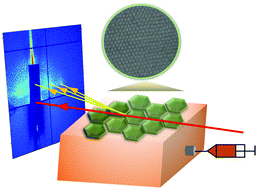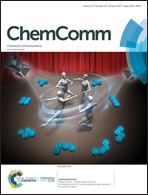In situ formation of electronically coupled superlattices of Cu1.1S nanodiscs at the liquid/air interface†
Abstract
We report on the in situ monitoring of the formation of conductive superlattices of Cu1.1S nanodiscs via cross-linking with semiconducting cobalt 4,4′,4′′,4′′′-tetraaminophthalocyanine (CoTAPc) molecules at the liquid/air interface by real-time grazing incidence small angle X-ray scattering (GISAXS). We determine the structure, symmetry and lattice parameters of the superlattices, formed during solvent evaporation and ligand exchange on the self-assembled nanodiscs. Cu1.1S nanodiscs self-assemble into a two-dimensional hexagonal superlattice with a minor in-plane contraction (∼0.2 nm) in the lattice parameter. A continuous contraction of the superlattice has been observed during ligand exchange, preserving the initial hexagonal symmetry. We estimate a resultant decrement of about 5% in the in-plane lattice parameters. The contraction is attributed to the continuous replacement of the native oleylamine surface ligands with rigid CoTAPc. The successful cross-linking of the nanodiscs is manifested in terms of the high electrical conductivity observed in the superlattices. This finding provides a convenient platform to understand the correlation between the structure and transport of the coupled superstructures of organic and inorganic nanocrystals of anisotropic shape.



 Please wait while we load your content...
Please wait while we load your content...